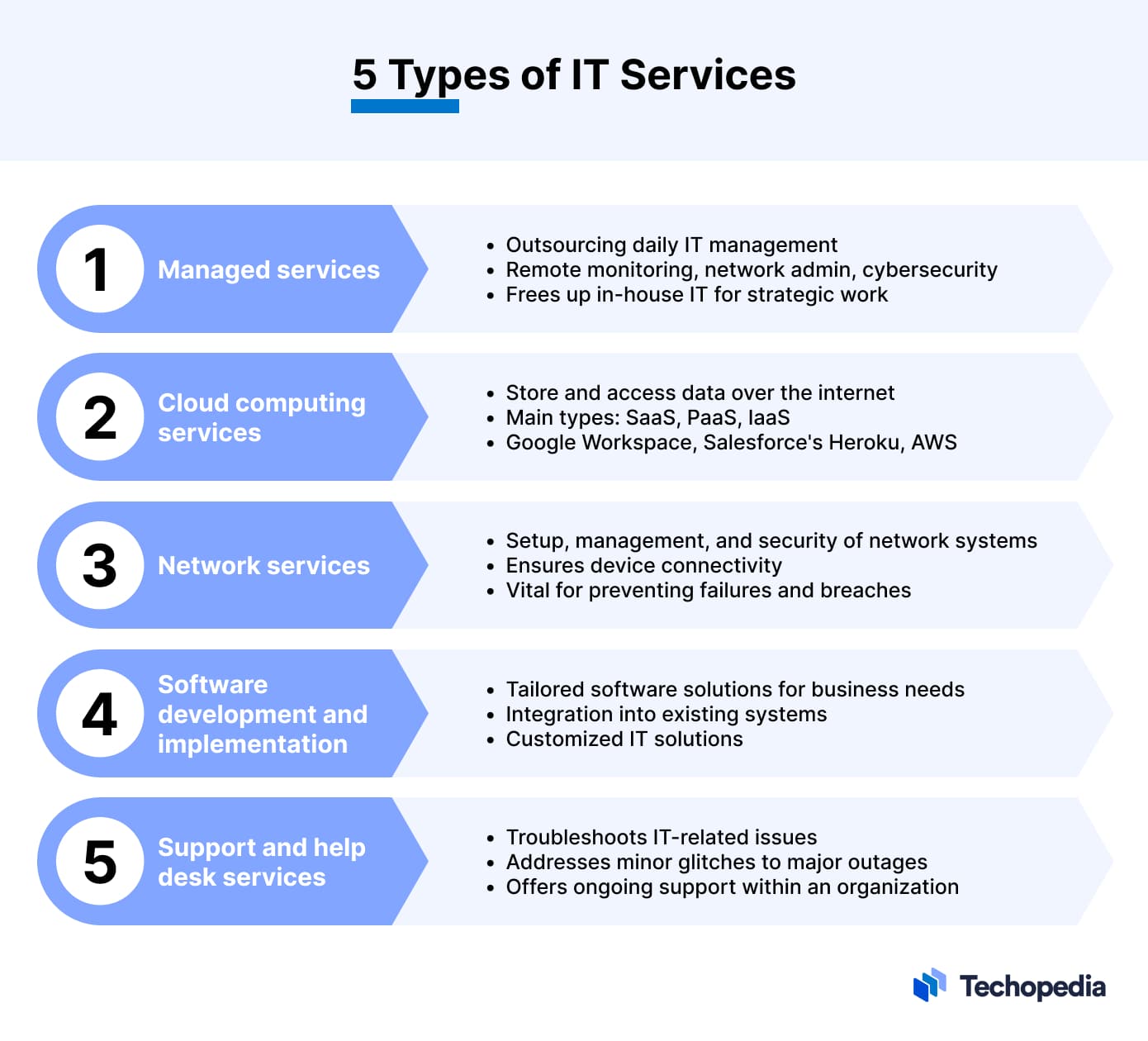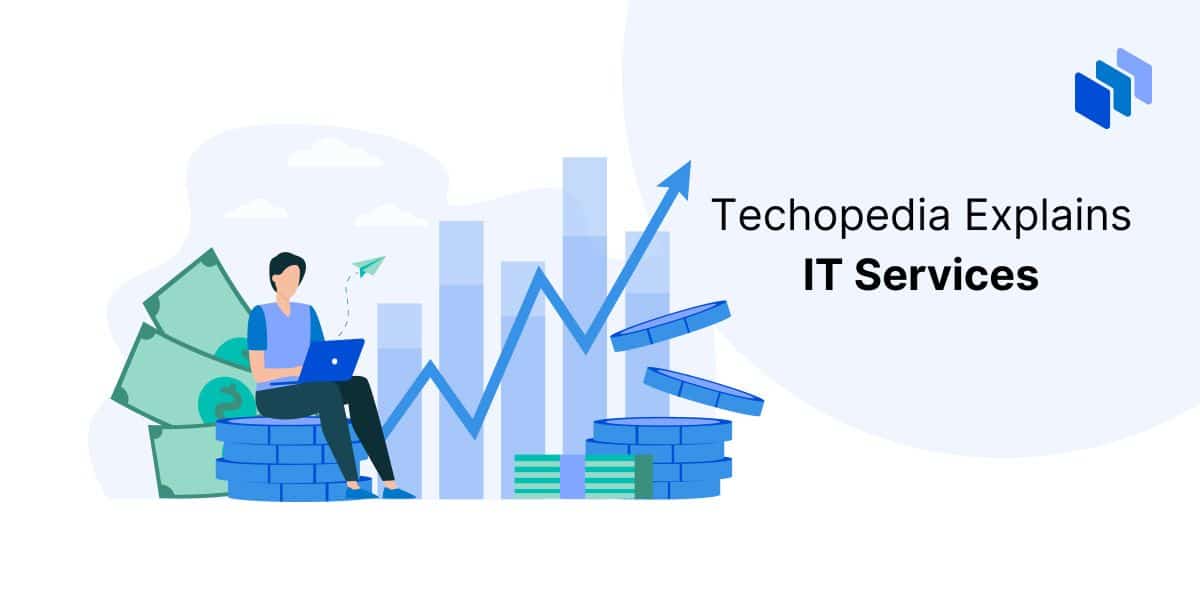What are IT Services?
IT services – or technology services – are a range of activities involving the use of information technology to support, manage, and improve the operations of a business or organization.
This encompasses a broad spectrum of services, like managing and maintaining IT infrastructure, developing and implementing software solutions, providing technical support, and protecting digital assets from cyber threats.
Techopedia Explains
IT services are not a one-size-fits-all solution. They are tailored to meet the specific needs of an organization. They can range from basic IT support, like fixing a broken printer, to more complex tasks, such as developing software or managing large-scale cloud computing infrastructures.
Nearly every aspect of business and organizational operations hinges on technology. Efficient IT services ensure that these technological aspects run smoothly and without interruption.
Without proper IT support, even the most mundane tasks can turn into annoying hurdles, slowing down operations and affecting productivity. This translates to money lost for the company.
The digital world doesn’t stand still, either. New technologies keep popping up, and old ones become obsolete faster than you can say “update.”
IT services are not just about keeping the lights on and the servers running. They’re about making sure your business doesn’t get left behind. They’re not just about patching up what’s now. They’re about being prepared for what’s next.
Types of IT Services

There are various types of IT services that businesses commonly use. Each type addresses specific tech needs, from keeping daily operations smooth to tackling the more complex, strategic IT initiatives. Here are a few of the most common ones.
Managed Services
Managed services involve outsourcing daily IT management for specific functions. It’s essentially like hiring an external team to handle the technical stuff, so you don’t have to worry about it.
Examples include remote monitoring and management of servers, network administration, and cybersecurity services.
Companies use managed services to offload general tasks, which allows their in-house IT team to focus on more strategic initiatives.
Cloud Computing Services
Cloud computing services are a staple in the modern IT world. These services store and access data over the internet rather than on a hard drive.
There are three main types, but there are many more:
- Software as a Service (SaaS): Here, the software is available via a third party over the Internet. Think of tools like Google Workspace or Microsoft 365.
- Platform as a Service (PaaS): This provides a platform allowing customers to develop, run, and manage applications without the complexity of building and maintaining the infrastructure. An example is Salesforce’s Heroku.
- Infrastructure as a Service (IaaS): This provides virtualized computing resources over the internet, like Amazon Web Services (AWS) or Microsoft Azure.
Network Services
Network services cover the setup, management, and security of network systems. This is about ensuring that all your computers, servers, and other network devices are connected and talking to each other in a secure and efficient manner.
It’s a critical part of IT services, considering the disastrous consequences of network failures or breaches.
Software Development and Implementation
This service involves developing custom software solutions tailored to a business’s specific needs and integrating these solutions into existing systems.
It’s about creating software that does exactly what you need it to do – a kind of tailoring for your IT systems.
Support and Help Desk Services
Support and Help Desk services are the IT world’s troubleshooters. They provide ongoing support for all IT-related issues within an organization. Whether it’s a minor glitch in your email system or a major system outage, these services are there to help figure out what went wrong and fix it.
The Evolution of IT Services
The evolution of IT services is a tale of constant adaptation and change. In the early days, IT was all about the basics: setting up computers, installing software, and keeping everything running. As technology advanced, so did IT services.
The 90s saw the rise of the internet and a shift towards network management and online presence. The 2000s brought about the era of data, with services expanding to include data storage, management, and security.
Nowadays, IT services have taken a leap into the future with innovations like Artificial Intelligence (AI), the Internet of Things (IoT), and cloud computing.
AI is transforming IT services by automating routine tasks and offering intelligent insights. IoT connects everyday devices to the internet, opening up new opportunities for remote monitoring and management.
These advancements are fundamentally reshaping how IT services are delivered and what they can achieve. They make IT services more efficient, proactive, and integral to the success of modern businesses.
How to Choose the Right IT Service Providers
Choosing the right IT service provider can make or break a business. You need someone reliable.
Here are some factors to consider before signing the dotted line.
Factor
Description
Expertise
Look for a provider with a solid background and a proven track record in the services you need.
Reliability
Their history of uptime and how they handle outages is key. A reliable provider means less headache for you.
Support
Check how they handle customer service. Quick response times and knowledgeable support can be a lifesaver.
Cost
It’s about value, not just the price tag. Weigh their services against the cost to ensure you’re making a cost-effective choice.
Speaking of dotted lines, once you have found an IT service provider that checked all of the above boxes, you’ll then need to evaluate the Service Level Agreement (SLA). An SLA is essentially the promise that the IT service provider should keep.
Consider these factors:
- Uptime Guarantees: Look for high percentages. More uptime means better reliability.
- Response Times: How quickly will they react when there’s an issue? Faster is always better.
- Penalty Clauses: If they fail to meet their promises, what are the consequences? This shows their commitment to their service standards.
When shopping for an IT service provider, make sure you find a partner that aligns with your business’s needs and goals.
Challenges and Solutions in IT Services
- Dealing with cybersecurity is one of the biggest concerns with IT services. The threat landscape is always changing, requiring a dynamic approach to security. This includes implementing up-to-date security measures, conducting regular system audits, and training employees to minimize human error.
- Staying updated with technological changes in IT is also important. The field is in constant flux, requiring an unwavering commitment to staying current. Regular training for staff, attending industry events, and staying informed about new developments are key strategies.
- Encouraging a culture of innovation within the organization can also help in adopting and adapting to new technologies efficiently.
- Managing costs and ensuring a good return on investment (ROI) is another challenge in IT services. It’s important to evaluate IT investments carefully, ensuring they align with the company’s goals and offer tangible benefits.
- Regularly review IT spending against the value and efficiency it brings to the business. Investing in IT should be seen not just as a cost but as a strategic investment for the business’s future growth and efficiency.
Overall, managing IT services effectively requires a blend of strong security measures, staying current with technology, and smart financial planning.
The Bottom Line
The significance of IT services stretches far beyond just fixing computers or setting up networks. It’s about ensuring seamless operation, securing data, driving innovation, and keeping up with the relentless pace of technological advancement.
The impact of these services is profound: they can make or break a business’s efficiency, security, and ability to compete.
Looking ahead, the future trajectory of IT services seems geared towards even more integration with emerging technologies like AI, IoT, and cloud computing. The focus is likely to shift towards more proactive, predictive approaches in IT management and cybersecurity.
The role of IT services is set to become more central, not just in solving technical issues but in shaping business strategies and driving growth.
As technology continues to advance at a breakneck speed, the importance of robust, forward-thinking IT services will only become more pronounced.






